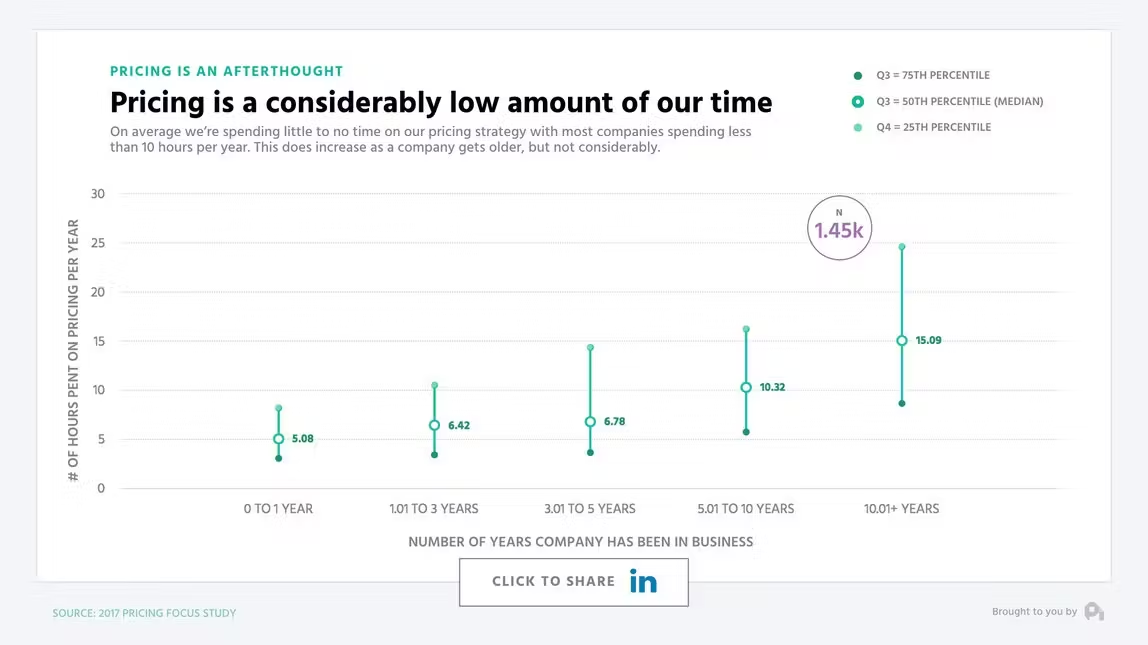How to optimize your pricing
Deciding on the right product pricing strategy —a price that maximizes value for customers and profit for you—starts with gaining a deep understanding of your customers. Price optimization is all about understanding who your best customers are, what features they like, and what features they need. You also need to understand your market: retailers will have different considerations than B2B companies. Once you understand that, you can align your pricing with what they value, tracking the results of the price changes you make and improving over time.
1. Get to know your customers
Optimizing your pricing is all about the data—both qualitative and quantitative. Hard data is the only way to find out how much customers are willing to pay for your product, and it’s the key to breaking free from the guessing cycle.
Quantitative data, like transactional data, customer reviews, supply and demand data, churn rate, MRR, and more show you how you’re doing and what needs to be changed. Software like Price Intelligently can help you make sense of those metrics and turn them into pricing insights by slicing and dicing your data based on demographic, psychographic, and customer preferences.
Just as helpful, qualitative data comes from talking to customers. Surveys are great, but they’re no match for picking up the phone and actually talking to customers, asking them about topics such as their price sensitivity and what features or benefits they value most in your product.
2. Quantify value
Once you’ve collected all your customer data, it’s time to work out what “value” actually means to your customers. That means working out your value metric. Your value metric is essentially what and how you’re charging for your product—identifying and pricing along your proper value metric is the difference between surviving and thriving.
Check out this pricing page example from user analytics service Hotjar. Hotjar’s value metric is pageviews—the price increases depending on how many pageviews your site handles per day.
Other common value metrics for SaaS companies include the number of seats, the number of files hosted, bandwidth used, and more. Your value metric should align with your customers’ needs and should be easily scalable.
3. Analyze the data
You’ve collected some customer data and worked out what your customers value—now it’s time to look for patterns in the features, benefits, price points, and value metrics that drive or detract from value. You’ll also find out how willing different segments and personas are to pay different prices for your products.
Use your findings to create tiers and proper packages for your product or services. Each tier should be priced along your value metric, and should align with your different buyer personas so that you're offering the right amount of product or service to each customer segment.
4. Adjust pricing and monitor
Even once you’ve set your prices, you’re still not done with price optimization—the value you provide versus your competitors’ is constantly changing, so you need to be constantly monitoring and adjusting your pricing.
Pricing is an ongoing process. You should use your pricing strategy to eliminate as much doubt as possible. Think back to our dartboard example from earlier—adjusting your pricing helps eliminate sections of the dartboard, focusing in on the right region for your dart to land as you learn more about what works.
You need to continually collect data and analyze the value customers are getting from your product to make sure that what you’re offering still meets your customers’ needs and pricing desires. Make sure you keep a very close eye on your pricing, and see how customers respond. If need be, re-evaluate and change things up—but don’t be too quick to switch, since you might alienate potential or existing customers.
Example #1: Pinegrow takes Brazil (eventually)
Pinegrow, the website building software, were seeing this exact issue when selling to customers in Brazil in USD at the same price point as their home market.
When they decided to not only offer Brazilian Real (BRL) on their checkout but also lower their prices to reflect what people were actually able - and willing - to pay in Brazil, they saw a considerable amount of new customers.
This increase in customer volume outweighed the discounted price, ultimately increasing Pinegrow's revenue in that market. The BRL prices that Pinegrow used were over a third lower than their initial USD equivalent. Far from harming their bottom line, they saw their sales leap a massive 177% even with that heavy discount.
Knowing your customer and their buying power is a great way to maximize conversion, especially in emerging markets.
So, what do you have to consider when researching the territory or territories you want to expand into? Let’s have a look at the main factors:
- Currencies that people use
- Disposable income
- Local pricing of competitors
- The size of your industry in that market
- General demand for your product
If this is somewhere you think your business is losing out on revenue due to the lack of a considered approach, then I suggest you hop on over to read our full guide to pricing localization.
Example #2: Tweakbit do some tweaking
Tweakbit sells anti-virus software in a very competitive market, and because they buy the software to solve a particular need (no one likes a computer virus), they don’t necessarily have strong brand loyalty. This could put them in the ‘high’ category of sensitivity.
...Which is exactly what Tweakbit’s pricing is designed to address. With some heavy discounting, both upfront and as the customer moves through the buying journey (in the form of time-based promotions), Tweakbit encourages their customers to view their software as a real bargain. On top of that, they also run regular coupon and promotion campaigns to ensure that customers’ pricing expectations are met.
The main takeaway here is that companies need to strategically determine the right price and billing models for their specific customers, using research, market knowledge, and customer insights.
.jpeg)

